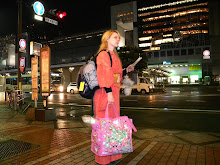


Last weekend, my friend Michelle and I decided to hit up Seoul's largest fish market, Noryangjin. After a 20 minute ride on the subway, we exited at the station suggested by our guidebook. The guidebook gave no further directions, nor was there need for any. The smells there could wipe you out. The air was saltier and fishier than that near any beach. Following the smells, we entered a long concrete building where vendors were setting up for business. Men and women wearing knee high rubber boats and plastic aprons in vivid pinks, greens, reds, and yellows were pouring plastic bags of fish into large aquariums. Other vendors had set up early and were smugly sitting behind their aquatic displays, waiting for business.


Everywhere, there were fish. I saw octopus, eels, stingrays, sea worms, sea squirts, crabs, assorted crustaceans, and probably hundreds of different fish, including small sharks. It was like a dark version of Sea World. You could admire all the unique sea creatures, and if you liked, you could eat them. Some of the fish were already dead, such as the octopus stung through the head on a wire, like grisly party garlands for The Little Mermaid. Most of the animals, however, were alive and writhing in their crowded tanks. The mutant crabs, larger than the circumference of my head, seemed the liveliest and the most intent on escape. I would not at all have been surprised if I'd seen a few of them scuttling along the subway platform, hoping to hitch a ride back to Incheon or to whichever oceanic community from which they'd come.

I peered closely into one particular tank. The man nearby pulled out a fish with his net to allow me closer inspection. "How much?" I asked curiously. "10,00 won," the man said. "8,000!" I countered, an automatic haggling reflex. With that, the man flung the fish to floor and, excitedly shouting something in Korean, bludgeoned it to death.
No returns, no exchanges.
For all the meat and seafood I consume, this was the first time I'd ever actually witnessed something die in order to become my meal. The fish I'm used to eating comes in neatly pressed little squares or sticks, cute geometries that in no way resemble an actual fish. I began to doubt my pro-omnivore position. Vegetarianism all of a sudden seemed, well, less vicious.
A nearby woman scooped up the fish and brought it into her restaurant. There were various restaurants set up along the side of the fish market. Some made arrangements of sashimi, which is raw fish similar to sushi, while others boiled up fish stew, and still others just grilled or baked the seafood to simple perfection.


Michelle and I followed the woman into her restaurant and seated ourselves on mats by a low table. After a ten minute wait and handing over several thousand extra won for food preparation, the fish was delivered to our table. I took one bite and decided to retain my omnivore status. It was undoubtedly the freshest, flakiest, most tender fish I've ever tasted. Most of it I ate without seasonings, though the restaurant lady was eager for me to douse the fish in soy and wasabi, so I ate some of it that way, too. Either way, it was delicious.


































.JPG)







